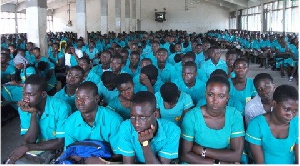Opinions of Tuesday, 21 May 2024
Columnist: Mileba Godwin Kwame
Do Ghanaian senior high school students truly grasp their lessons, or are they just memorizing facts?
Education is essential for national development, with senior high schools in Ghana playing a crucial role in preparing students for further education and future careers. However, there are growing concerns about whether students in these schools genuinely understand the material they are taught.
Let's explore the various factors that impact student comprehension, including teaching methods, curriculum relevance, student engagement, educational infrastructure, and assessment practices, and provide practical examples.
Teaching Methods: Too Much Theory, Not Enough Practice:
A significant issue in Ghanaian senior high schools is the emphasis on theoretical teaching. Many teachers rely heavily on lectures, where they deliver information while students listen passively. This approach can efficiently cover a lot of material, but it often fails to engage students deeply or help them retain information effectively.
Practical Example: In a chemistry class, students might learn about chemical reactions and equations from textbooks and lectures. However, without conducting experiments, such as mixing chemicals to observe reactions first-hand, their understanding remains superficial. A school with a well-equipped laboratory allows students to perform these experiments, making abstract concepts concrete and memorable.
Curriculum Relevance: Connecting Learning to the Real World:
The curriculum also affects how well students understand their lessons. While Ghana's education system has made efforts to update the curriculum, there are still gaps between what is taught and its real-world applications. Subjects are often taught in isolation without showing how they connect to each other or to everyday life.
Practical Example: Incorporating practical financial literacy into the economics curriculum can help students understand budgeting, saving, and investing. For instance, students could manage a mock investment portfolio, learn to track stocks, calculate gains and losses, and understand market trends. This hands-on experience bridges the gap between theoretical knowledge and practical application.
Student Engagement: Encouraging Active Participation:
Student engagement is another critical factor in understanding. Active participation in learning can significantly improve comprehension, but many students in Ghanaian senior high schools are used to being passive learners. This passivity is due in part to large class sizes, where individual attention is rare, and cultural norms that discourage questioning and debate in the classroom.
Practical Example: Introducing debate sessions in literature classes can enhance understanding. When students debate themes, characters, and moral questions from novels, they engage critically with the material, developing deeper insights. For example, debating the ethical dilemmas in Chinua Achebe’s “Things Fall Apart” can make students analyse and understand the text more thoroughly.
Educational Infrastructure: The Role of Resources and Training:
The resources available to schools also impact student understanding. Many schools lack essential resources like textbooks, laboratory equipment, and technology, which are vital for effective learning. Additionally, continuous professional development for teachers is often neglected. Providing ongoing training can help teachers learn new teaching strategies and improve classroom management.
Practical Example: A school with access to computers and internet connectivity can enhance learning through online educational resources. Teachers trained in digital literacy can incorporate multimedia presentations, virtual simulations, and online quizzes into their lessons, making learning more interactive and engaging. For instance, using virtual labs for biology lessons allows students to simulate dissections and experiments that may not be feasible in a physical lab due to resource constraints.
Assessment Methods: Moving Beyond Memorization:
Assessment methods in Ghanaian senior high schools often focus on rote memorization and regurgitation of facts. While standardized exams are necessary, they should be complemented with other forms of assessment that evaluate students' analytical and practical skills. Project-based assessments, oral presentations, and practical exams can provide a more comprehensive picture of students' understanding.
Practical Example: In history classes, instead of solely relying on written exams, students could be tasked with creating documentaries on historical events. This project would require them to research, script, and produce a video demonstrating their understanding of the event and its significance. This method assesses their grasp of historical facts and their ability to present and analyse information creatively.
Learning Environment: Impact of Class Size and School Facilities:
Class size is another critical factor affecting student understanding. Overcrowded classrooms make it difficult for teachers to give individual attention to students. This lack of personalized instruction can hinder students who may need extra help to grasp complex topics. Smaller class sizes allow for more interactive and personalized teaching, which can significantly enhance understanding.
Practical Example: A class size reduction initiative where each teacher is responsible for no more than 25 students can transform the learning experience. Teachers can offer more personalized feedback, engage students in discussions, and identify individual learning needs more effectively. For instance, in a smaller math class, a teacher can provide one-on-one tutoring to students struggling with specific concepts, ensuring they understand the material before moving on.
Teacher-Student Relationship: Building Trust and Encouragement:
The relationship between teachers and students can greatly influence how well students understand their lessons. Teachers who build a rapport with their students, encouraging them to ask questions and express their thoughts, create a positive learning environment. This trust and encouragement can boost students' confidence and willingness to engage with the material.
Practical Example: Teachers who hold regular office hours or informal study sessions can foster better relationships with their students. For instance, a history teacher might organize weekly after-school discussion groups where students feel comfortable asking questions and exploring topics in greater depth. This approach not only clarifies doubts but also builds a supportive learning community.
Parental Involvement: Support Beyond the Classroom:
Parental involvement in a child’s education is crucial. Parents who take an active interest in their children's schoolwork and provide support at home can enhance their children's understanding and performance. This support can come in various forms, such as helping with homework, encouraging good study habits, and communicating regularly with teachers.
Practical Example: Schools can organize workshops to equip parents with the tools to support their children’s education. For example, a workshop on creating effective study schedules can help parents guide their children to manage their time better. Additionally, schools can establish parent-teacher associations (PTAs) that foster closer collaboration between parents and educators, ensuring that students receive consistent support both at home and school.
Cultural Factors: Attitudes toward Education:
Cultural attitudes towards education also play a significant role in how well students understand their lessons. In some communities, there is a strong emphasis on passing exams and obtaining certificates rather than on actual understanding and knowledge application. This focus on rote learning can hinder deeper comprehension and critical thinking.
Practical Example: Schools can organize community outreach programs that emphasize the importance of understanding and applying knowledge. For instance, science fairs where students demonstrate projects to the community can show the practical applications of their learning. This can shift the focus from mere exam performance to appreciating the broader value of education.
Conclusion: Creating a Better Learning Environment:
In conclusion, while students in Ghanaian senior high schools are receiving education, their depth of understanding is questionable due to current teaching methods, curriculum relevance, student engagement, educational infrastructure, and assessment practices. Addressing these issues requires a holistic approach, involving reforms in teaching strategies, curriculum design, resource allocation, and assessment methods.
By fostering an educational environment that emphasizes comprehension over memorization, Ghana can ensure that its students are well-educated and capable of applying what they have learned, which is essential for national development. Investing in smaller class sizes, improving school facilities, nurturing positive teacher-student relationships, and increasing parental involvement are all steps that can significantly enhance student understanding. Additionally, cultural shifts towards valuing deep learning over rote memorization are crucial for long-term improvements.
These changes will not only benefit individual students but also contribute to the overall progress and development of the nation. By implementing practical examples and strategies, Ghana can create a more effective and engaging educational system that truly benefits its students.













